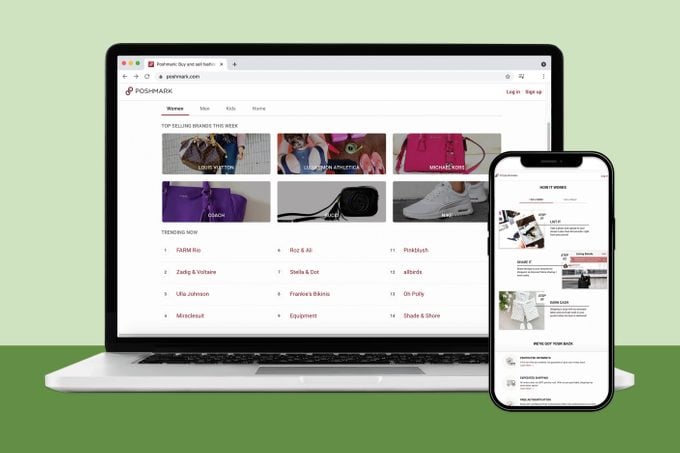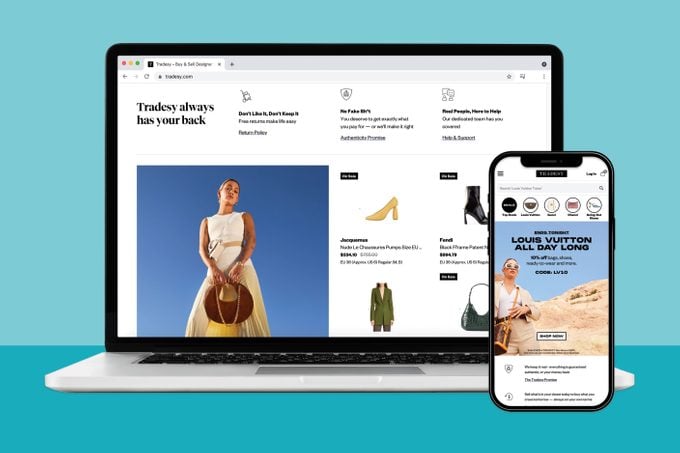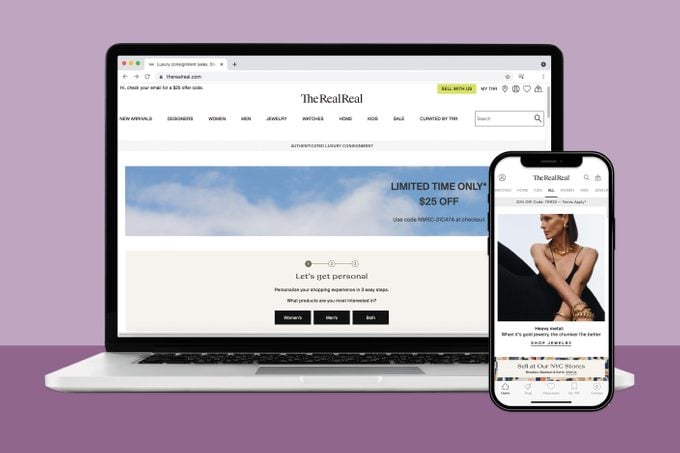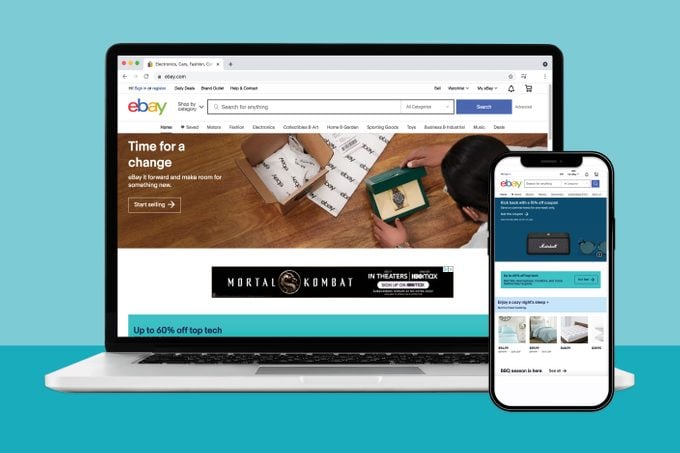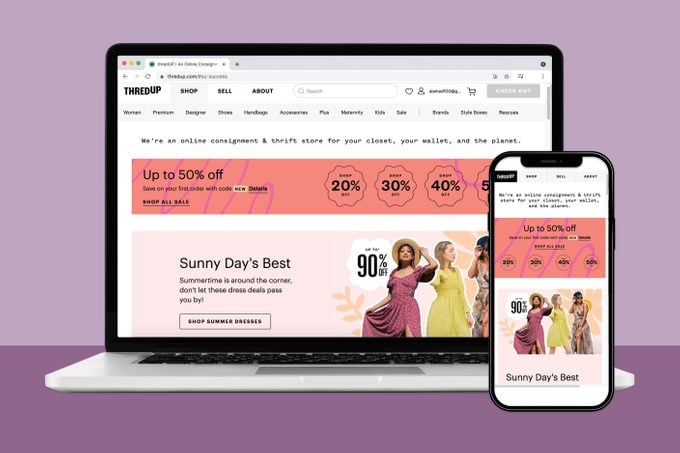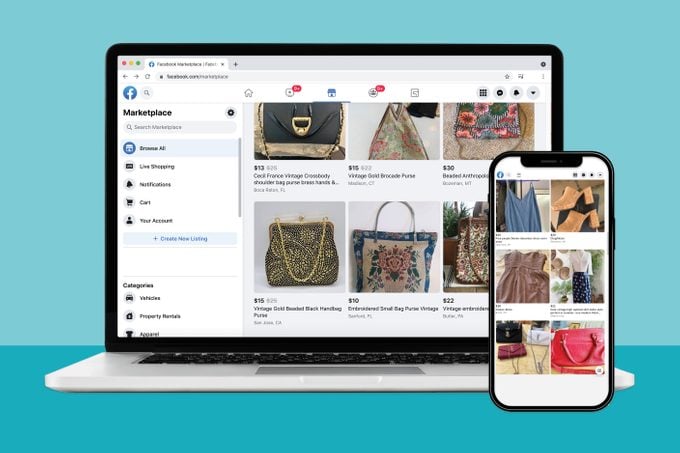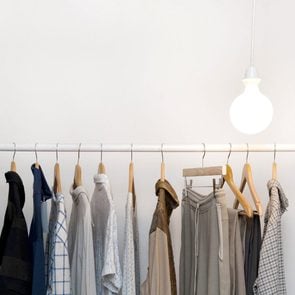Where to Sell Old Clothes to Get the Most for Your Money
Updated: Feb. 01, 2024
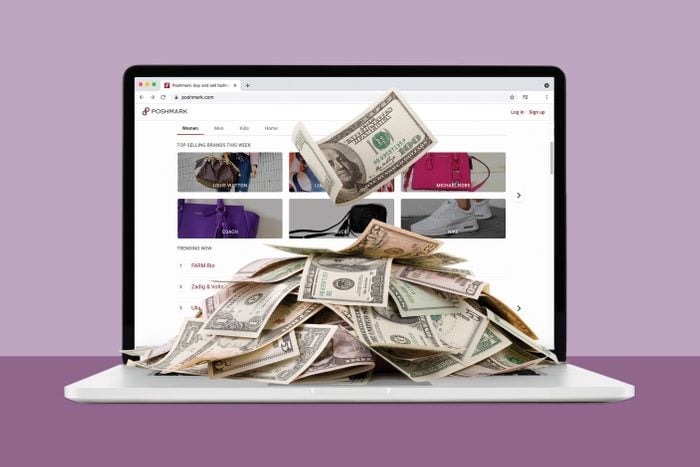
It's never been easier to make a profit on pre-loved goods. Here's how to turn your closet cast-offs into cash.
We’re willing to bet that your wardrobe is filled to the brim with garments and accessories you never wear. If that’s the case, it’s time to initiate a closet cleanout and get paid for your surplus stuff. The first step is to figure out if your threads are worth any money. Unfortunately, just because you dropped a lot of dough on something, it doesn’t mean it has a high resale value. “One person’s trash is not always another person’s treasure!” says celebrity stylist Jennifer Austin. Do some research to see if the item is something people are currently buying. To figure that out, go to a site or app, search for what you want to sell, and then filter results by items that have “sold.” You’ll be able to see if it’s in demand, as well as the going prices for it.
The best places to sell clothes online are the sites that give you the highest return, of course, and we’ve got a few ideas for everything from designer clothing and athleisure to handbags and watches. You can take that money and pay off some bills—or use it to finance your next purchase. “I sell and then use the profits to pay for the new things I want to buy each season,” says Julie Ann Clauss, founder of The Wardrobe, a professional fashion archiving and storage service. “It’s fun and empowering.” You can also sell your other unwanted and old items to do your bit to make life more sustainable.
In addition to the monetary rewards, a decluttered space will give you peace of mind, and a streamlined closet will help you create the perfect capsule wardrobe filled with timeless essentials you can easily mix and match, which makes getting dressed a breeze. It’s also the responsible thing to do. The fashion industry is actually extremely harmful to the environment. According to the Environmental Protection Agency, Americans send more than 11 million tons of textile waste to landfills each year. And the Council for Textile Recycling reports that the average person throws away 70 pounds of clothing and other textiles annually. Luckily, sustainable fashion is just a click away.
The bottom line: There’s a lot you can do to reduce your fashion footprint and extend the life cycle of your wardrobe. Giving a new life to your old items is a good way to start—and it doesn’t hurt that you’ll earn some cash in the process. Here are your best bets for selling those unwanted clothes. Then, learn how to organize a closet to keep your wardrobe in order.
Poshmark
This website and app puts the power to sell in your hands. Simply snap some photos, set a price, and upload. It’s known as one of the best places to sell clothes online for its ease and convenience—the whole process can take less than 60 seconds! Each item will be added to your “closet,” where you can share and promote listings in themed “parties.” Buyers can make you an offer, so be prepared to negotiate. Also be aware that Poshmark takes a flat fee of 20 percent, no matter how big or small the profit.
A big plus? How easy they make the shipping process. Buyers pay $7.45 (no matter the size of the item), and as soon as something sells, you are instantly sent a prepaid USPS label. Use any box, or the post office’s free shipping supplies, and off it goes! Once the buyer receives and approves the purchase (they have three days to do so), the funds are automatically released into your account.
Another benefit of Poshmark is that buyers are seeking both high-end designers and fast-fashion companies. The site regularly releases blogs discussing the brands that are trending (currently: Gucci, Louis Vuitton, Aritzia, Reformation, Zara), plus the popular styles people are searching for (like bodysuits, jumpers, and rompers), so you can always stay up to date on what’s in demand. You can sell pretty much anything, too, including women’s and men’s clothes, beauty products, home decor, and they even recently added pet accessories.
Tradesy
The goal of this woman-owned company is to make selling simple. Create your own listings, and use their unique features to boost your sales—like complimentary image enhancing, which they say helps items to sell up to 25 percent faster. Choose your price, or they’ll suggest one based on smart data and details. A flat commission fee of $7.50 is deducted for anything under $50, and 19.8 percent for anything over $50.
Laurie Trott, Head of Brand at Tradesy, tells Reader’s Digest that handbags and sunglasses are two consistently popular categories. “People are also dressing up again, and it’s reflected in their purchases,” she adds. “There’s been an uptick in sales of jewelry, high heel sandals, and clothing with ornate detail.” Trott also says there’s a current demand for ’90s and Y2K-era luxury pieces. The range of favored designers includes classic heritage companies like Louis Vuitton and Prada, as well as more contemporary brands like Staud, Ganni, and Nanushka. One perk sellers love: The buyer pays for shipping, plus you can request a free Tradesy shipping kit, which includes branded packaging, a prepaid label, and everything you need to send off your garb in style.
The RealReal
If your wardrobe is packed with Prada, Chanel, Fendi, and other high-end pieces, then this is the best website to sell your clothes and accessories. Considered the leader in luxury consignment, they’re the only secondhand company that authenticates every single item they sell. Hundreds of experts and brand authenticators, including gemologists and even watch connoisseurs, inspect thousands of items each day. It is one of the reasons their 20 million members trust, and shop, their swanky selections.
Commission is based on a sliding scale, so the more you sell, the more you earn. For beginners, what you make will be based on the price of your item (anything $145 or less gets you 40 percent, $146–$195 earns you 50 percent, and so on). While you don’t have control over what your item is priced at, you can schedule a video call or email a local representative to see if the site will accept your items and get an estimate on what they would sell for. From there, you can arrange a home pickup or drop-off, or request a free shipping label to send in your goodies.
Here’s an important tip, courtesy of Sasha Skoda, The RealReal’s Head of Women’s: During the COVID era, she says, shoppers have been gravitating toward investment pieces, from “timeless handbags to joy-sparking fine jewelry.” The Louis Vuitton Neverfull is the site’s top-selling tote, and pieces from Cartier’s Love Collection and Tiffany & Co.’s T Collection are selling close to their original retail prices. The best part? Their team will do all the hard work for you, including photographing, measuring items, writing descriptions, listing, and shipping the pieces to their new homes.
Mercari
This secondhand marketplace has paid more than $1 billion to sellers since its launch in 2014. The Mercari app has also been downloaded by more than 50 million users, so if you’re looking for the best place to sell clothes online with lots of built-in customers, this is it. Users create listings themselves, and whatever sells is subject to a flat 10 percent fee. If it fits in a box, it’s fair game, so you can move almost anything—from clothing to electronics to toys and beauty products. For anything heavier or if you’re looking to sell in bulk, a new service called Mercari Now (currently offered in New York City, San Francisco, and Houston) is available for $10.99. A Postmates driver will pick up your item within hours of its sale and drop it off at the buyer’s doorstep in as little as two hours. This means you get paid faster than if you’d have to wait for standard shipping.
Mercari’s Head of Marketing, Roxane Duka, tells Reader’s Digest that lately, they’ve noticed a lot of growth in athletic apparel from brands like Nike, Lululemon, and Adidas. “If you have athleisure or designer accessories you’re no longer using, particularly from Coach, now is a great time to sell,” she reveals. She shares other big hits: “Mercari shoppers are looking for Victoria’s Secret and PINK apparel, and jeans—specifically, wide-leg—are also in high demand right now.”
RELATED: Purse Storage Ideas You’ll Wish You Knew Sooner
eBay
This is an oldie but a goodie. Throughout the years, eBay has remained a favorite resale site, and with 185 million active buyers, it’s easy to see why. According to a recent commerce report from the company, Americans have an average of 36 household items that can be sold on eBay for around $3,600—all things that would otherwise be donated or thrown out. While eBay’s offerings run the gamut from cars to Cuisinarts, its price structure is most favorable for clothing sellers. The first 200 auction-style listings are free (each additional one is $.30 after that), and you pay a 10.2 percent fee on the total price of the item. Have some fancy sneakers you want to unload? There are no final value and insertion fees for kicks when the starting price is over $100. What’s more, it’s easy to reach an international audience with eBay’s Global Shipping Program. All you have to do is send your item to their domestic shipping center and they’ll take care of the rest.
thredUP
Consider this the best place to sell clothes online if you want to earn some extra cash without a lot of effort. Request a “clean out kit” and send the bag back (for free!) filled with any gently used pieces you want to hawk. They’ll do all the work to photograph, price, and list it, which means sellers take a lower cut (anywhere from 5 to 80 percent, depending on the resale price, seasonality, and condition). The positive side is the quantity the company can process: They list an average of 280,000 items each week, and their distribution centers can currently hold a whopping 5.5 million items. Plus, thredUP accepts more than 35,000 women’s and children’s brands from Gap to Gucci.
Madeline Aaronson, thredUP’s brand director, tells Reader’s Digest that Frye boots, Patagonia jackets, and Michael Kors handbags are a few examples of wardrobe staples that hold their value over time and are always big crowd-pleasers. Other beloved labels include Everlane, Reformation, and The North Face. “Many people are surprised to learn that secondhand activewear is pretty much always in high demand, particularly from brands like Lululemon and Nike,” reveals Aaronson. Do you have items that are too beat-up to be sold? Consider clothes recycling.
Vinted
There are no fees or expenses for sellers on this fashion-focused platform. Yes, you read that correctly. That means you get to keep 100 percent of your profits, which is why it’s one of the best places to sell clothes online. Instead, buyers pay a fixed amount of $0.70 for every purchase, plus five percent of the final price as a “Buyer Protection” cost. Vinted has more than 37 million registered members globally across 13 countries who are shopping for women’s, men’s, and children’s clothing, footwear, and accessories. The site offers tricks and tips to help move goods faster, including purchasing a “bump” for $0.95 per item. When you buy a bump, your listing is displayed to more members in Vinted’s newsfeed and search results—once a day for three consecutive days. Swapping is also allowed, making it a great opportunity to trade in any attire that might not be selling.
RELATED: Smart Strategies for Organizing Your Kid’s Closet
Facebook Marketplace
If you already spend all of your time on the social media site, you might as well make some money while doing so. To use Marketplace, you need to create a public listing that can be seen by anyone on and off Facebook. From there, you can share to groups or even your own network. If you aren’t comfortable with meeting up locally to exchange goods, you can also use a shipping option or a pickup or drop-off service. The best part? No seller fees or taxes!
Depop
This community-powered marketplace app has a cult Gen-Z following, but you don’t have to be part of that TikTok-loving generation to make money. Since its inception in 2011, sellers have made $1 billion. The social platform may remind you of Instagram’s interface because it’s set up in a similar fashion. Users’ profile pages have grid photos of listings (complete with clickable hashtags), and there’s a newsfeed and even an explore page. Vintage, streetwear, and one-of-a-kind items are the biggest categories here, and you’ll take home 90 percent from each sale. Like other social sites, having a large following has the potential to translate into big sales, but it’s not necessarily a requirement for success. You can attract buyers with eye-catching photos and by optimizing captions with descriptive keywords. Sellers say listing products at night (between 7 p.m. and 9 p.m.) is also helpful to catch your audience when they’re home and on their phones.
Tips for selling clothing online
Before you dive in, maximize your chances of success. The pros we interviewed had a few more suggestions you’ll definitely want to know before you list your items on any resale site or app.
- Condition is key. “As a rule of thumb, the better condition an item is in, the more it is worth,” says TheRealReal’s Skoda. “Whether it’s treating your sneakers with a good leather protector or simply storing your handbag in its dust bag when not in use, these care tips can go a long way in preserving an item’s resale value.”
- Clean it up. “Make sure your clothes are freshly laundered and free of holes, rips, or stains,” advises thredUP’s Aaronson. “Pretend you’re sending it to your BFF!”
- Write in-depth descriptions. A detailed and honest summary should discuss the condition (noting any imperfections or flaws), specific sizing and measurements, and fabric and material information. It’s also helpful to include the official brand color/phrase or style name as listed on either the tag or the original retailer’s website, so savvy designer enthusiasts who use keywords will easily find your listing.
- Post great images. To ensure items look their best, says Trott, always use a consistent backdrop with good lighting. It’s important to show multiple angles of the product, too. “For accessories, illustrating scale is also helpful to a buyer,” she adds. “For example, place an iPhone next to a mini bag to give it spatial context.”
- Make sure the price is right. Do your homework to ensure a timely transaction. “I recommend getting a sense of what kind of resale value a designer or style holds before selling an item,” says Skoda. Check listings on various marketplaces to help determine where to sell clothes, and also set a fair price.
- Keep track of expenses. Be sure to account for shipping (and packaging) costs. Some places charge buyers for postage, while others leave it up to the seller. Also, don’t forget to factor in any platform fees to ensure you turn a profit.
- Follow pop culture fads. See a trend surface on TikTok or your favorite Netflix show that you happen to have in your closet? Aaronson says it’ll likely be a quick sell. Jump on top of any popular fashion trends, particularly on apps to sell clothes, to maximize your potential to earn more money.
Now that your closet is a lot less cluttered, look into the best closet systems to organize your space, and then find out how to color-code your closet to keep everything tidy moving forward.
Sources:
- Jennifer Austin, celebrity stylist
- Julie Ann Clauss, founder of The Wardrobe
- EPA: “Facts and Figures about Materials, Waste and Recycling”
- The Council for Textile Recycling
- eBay: “Recommerce: Fueling Economic Opportunity and Sustainability”

